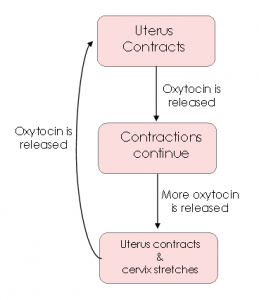Oxytocin is a hormone that plays a role in regulating: social interaction, sexual reproduction, maternal-child boding, labor, and milk production. They hypothalamus produces this hormone. Physical affection causes an increase in oxytocin levels.
Oxytocin in the Perinatal Period
Without a doubt, oxytocin is the do-it-all hormone when it comes to the perinatal period, starting from before conception! Oxytocin:
- is released during orgasm and nipple stimulation.
- works by positive feedback and plays a key role in mother-child bonding.
- can be used to induce or augment labor (it’s the drug pitocin).
- helps the uterus return to its pre-pregnancy size and tone.
- promotes movement of milk into the breast during nursing.
- speeds up delivery of the placenta and reduces the risk of heavy bleeding by contracting the uterus.
- Your doctor/midwife may order its administration after delivery to reduce the risk of heavy bleeding. Some providers will instead let you nurse your baby immediately after delivery for the same effect.
How does it work?
 Oxytocin functions via a positive feedback mechanism, which means the effects of its release stimulates the body to release more of it. When you’re in labor your uterus contracts causing your cervix to stretch. These actions stimulate your body to release oxytocin. This causes contractions to continue, which means your body releases more of it. Its buildup in the blood causes an increase in the frequency and intensity of your contractions. This process is self-limiting and it stops when your baby (and the placenta) have been delivered.
Oxytocin functions via a positive feedback mechanism, which means the effects of its release stimulates the body to release more of it. When you’re in labor your uterus contracts causing your cervix to stretch. These actions stimulate your body to release oxytocin. This causes contractions to continue, which means your body releases more of it. Its buildup in the blood causes an increase in the frequency and intensity of your contractions. This process is self-limiting and it stops when your baby (and the placenta) have been delivered.
The feedback mechanism works the same way during breastfeeding. Your letdown stimulates more to be produced and released. When your baby stops feeding, the loop stops. During nursing, oxytocin can also act on the uterus, which is why you may experience uterine cramping or contracting while breastfeeding.
Next in the Series
P is for Placenta Encapsulation
Q is for Queasiness
R is for Rh Factor
This article is for informational purposes only. It should not take the place of consultation with your healthcare professional.

